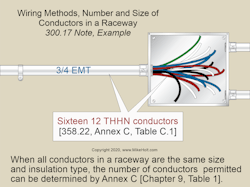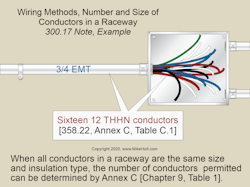Continuity of the neutral conductor of a multiwire branch circuit must not be interrupted by the removal of a wiring device [Sec. 300.13(B)]. So, splice the neutral wires, and run a pigtail to the device. However, you cannot do this with a GFCI device because it must sense the current in the neutral.
The opening of the phase conductors (or the neutral conductor of a 2-wire circuit while a device is replaced) does not cause a safety hazard, so pigtailing these conductors is not required [Sec. 110.14(B)].
At least 6 in. of conductor, measured from the point in the box where the conductors enter the enclosure, must be available for conductor splices or terminations [Sec. 300.14]. The 6-in. free conductor is permitted to be spliced or un-spliced. Boxes with openings less than 8 in. at any dimension must have at least 6 in. of conductor, measured from the point where the conductors enter the box and at least 3 in. of conductor outside the box.
Conductor splices and taps must be installed inside enclosures per Sec. 300.15. Splices are not permitted in raceways, except as permitted in Sec. 376.56 for wireways [Sec. 300.13(A)].
Boxes or fittings
Fittings and connectors must be used only with the specific wiring methods for which they are designed and listed. You cannot use Type NM cable connectors with Type AC cable, and you cannot use electrical metallic tubing fittings with rigid metal conduit or intermediate metal conduit unless listed for the purpose.
PVC conduit couplings and connectors are permitted with electrical nonmetallic tubing (ENT) if the proper glue is used per the manufacturer’s instructions [Sec. 110.3(B)]. See Sec. 362.48.
Conductors can be spliced in a conduit body per Sec. 314.16(C). A box must be installed at each splice or termination point, except as permitted by Sec. 300.15(A) through (L). For example:
- A box is not required for wiring methods with removable covers such as wireways, multioutlet assemblies, and surface raceways [Sec. 300.15(A)].
- A fitting identified for the use is permitted instead of a box or conduit body where conductors are not spliced or terminated within the fitting. The fitting must be accessible after installation unless it is listed for concealed installation [Sec. 300.15(F)].
- A box is not required where a listed nonmetallic-sheathed cable interconnector device is used for exposed cable wiring or concealed repair wiring in an existing building per Sec. 334.40(B) [Sec. 300.15(H)].
Number and size of conductors in a raceway
Raceways must be large enough to permit the installation and removal of conductors without damaging the conductor insulation [Sec. 300.17]. When all conductors within a raceway are the same size and of the same insulation type, you can use Annex C (Table 1) to determine the number of conductors permitted for a specific raceway size (see Fig. 1 below).
If you install different size conductors in a raceway, conductor fill is limited to the percentages in Table 1 and Note (6) of Chapter 9. Those percentages are based on conditions where the length of the conductor and the number of raceway bends are within reasonable limits [Chapter 9, Table 1, Table Note 1].
Follow these steps for sizing raceways:
Step 1: Determine the total area needed for the conductors (Chapter 9, Table 5 for insulated conductors and Chapter 9, Table 8 for bare conductors).
Step 2: Select the raceway from Chapter 9, Table 4 per the percent fill listed in Chapter 9, Table 1.
Here’s an example problem to show how this works.
What size Schedule 40 PVC conduit is required for the following conductors: 3 – 500 THHN, 1 – 250 THHN, and 1 - 3 THHN? See Fig. 2 below.
Solution:
Step 1: Determine the total area needed for the conductors [Chapter 9, Table 5].
500 THHN (0.7073 × 3 = 2.1219 in.2) 250 THHN (0.3970 × 1 = 0.3970 in.2) 3 THHN (0.0973 × 1 = 0.0973 in.2) Total Area = 2.6162 in.2
Step 2: Select the raceway at 40% fill [Chapter 9, Table 1 and Table Note (6), and Table 4].
Use trade size 3 Schedule 40 PVC because there is 2.907 sq in. of conductor fill at 40%.
Conductors in raceways
To protect conductor insulation during installation, raceways must be mechanically completed between the pulling points before pulling the wires [Sec. 300.18(A)]. See Sec. 300.10 and Sec. 300.12 for electrical and mechanical continuity of raceways. Short sections of raceways used for protecting cables from physical damage don’t have to be complete.
If a raceway’s vertical rise exceeds Table 300.19(A) values, each conductor must be supported at the top (or as close to the top as practical). Intermediate support must also be provided in increments not exceeding the values of Table 300.19(A) [Sec. 300.19(A)].
To minimize the induction heating of ferrous metal raceways and enclosures — and to maintain an effective ground-fault current path — all conductors of a circuit (including neutral and equipment grounding conductors) must be in the same raceway, cable, trench, cord, or cable tray [Sec. 300.20(A)]. See Sec. 250.102(E), Sec. 300.3(B), Sec. 300.5(I), and Sec. 392.20(C).
Where a single conductor carrying alternating current passes through metal with magnetic properties, the inductive effect must be minimized by either:
- Cutting slots in the metal between the individual holes through which the individual conductors pass, or
- Passing all the conductors in the circuit through an insulating wall large enough for all the circuit conductors [Sec. 300.20(B)].
Electrical circuits and equipment must be installed in such a way that the spread of fire or products of combustion will not be substantially increased [Sec. 300.21]. Openings around electrical penetrations of fire-resistant-rated walls, partitions, floors, or ceilings must be firestopped using approved methods to maintain the fire-resistance rating.
Wiring in ducts
Wiring methods cannot be installed in ducts that transport dust, loose stock, or flammable vapors [Sec. 300.22(A)]. Equipment is permitted within a duct fabricated to transport environmental air only if the equipment is necessary for the direct action upon, or sensing of, the contained air [Sec. 300.22(B)].
Type MC Cable without an overall nonmetallic covering and metal raceways can be installed in ducts fabricated to transport environmental air. Flexible metal conduits in lengths not exceeding 4 ft can be used to connect equipment and devices within the fabricated duct.
Wiring in environmental air plenums
For these spaces, you can use Type AC cable, Type MC cable without a nonmetallic cover, electrical metallic tubing, intermediate metal conduit, rigid metal conduit, flexible metal conduit, or (where accessible) surface metal raceways or metal wireways with metal covers [Sec. 300.22(C)(1)]. Cable ties for securing and supporting must be listed for use in a plenum space.
Metal cable tray systems can be installed to support the wiring methods and equipment permitted in a plenum space [Sec. 300.22(C)(2)(a)]. Electrical equipment with a metal enclosure or a nonmetallic enclosure listed for use in an air-handling space can be installed in a plenum space [Sec. 300.22(C)(3)].
Access panels and exit enclosures
Cables, raceways, and equipment installed behind suspended ceiling panels must be installed such that the panels can be removed to give access to electrical equipment [Sec. 300.23].
Where an exit enclosure is required to be separated from the building, you cannot install any wiring methods other than those serving the equipment that the authority having jurisdiction permits in the exit enclosure [Sec. 300.25]. As used here, “separated from the building” does not necessarily mean detached. Article 100 defines a “building” as “a structure that stands alone or that is separated from adjoining structures by fire walls.” For more information, see NFPA 101, Life Safety Code, 7.1.3.2.1(10)(b).
Collective wisdom
Why must vertically run conductors be supported at specific intervals? The substantial weight that accumulates in long vertical runs of unsecured conductors can cause them to drop out of the raceway (sometimes called a “runaway”). All too often, conductors in a vertical raceway have slipped from the pulling “basket” or “grip” (at the top) before being secured. Sheer weight and gravity take over, accelerating the conductors down and out of the raceway and injuring those at the bottom of the installation.
By following a specific rule for installing conductors and raceways, you prevent the known specific problem the rule exists to prevent. Every installer benefits from the collective wisdom, which, in some cases, was gained at the cost of human life.
These materials are provided by Mike Holt Enterprises in Leesburg, Fla. To view Code training materials offered by this company, visit www.mikeholt.com/code.
About the Author

Mike Holt
Mike Holt is the owner of Mike Holt Enterprises (www.MikeHolt.com), one of the largest electrical publishers in the United States. He earned a master's degree in the Business Administration Program (MBA) from the University of Miami. He earned his reputation as a National Electrical Code (NEC) expert by working his way up through the electrical trade. Formally a construction editor for two different trade publications, Mike started his career as an apprentice electrician and eventually became a master electrician, an electrical inspector, a contractor, and an educator. Mike has taught more than 1,000 classes on 30 different electrical-related subjects — ranging from alarm installations to exam preparation and voltage drop calculations. He continues to produce seminars, videos, books, and online training for the trade as well as contribute monthly Code content to EC&M magazine.



